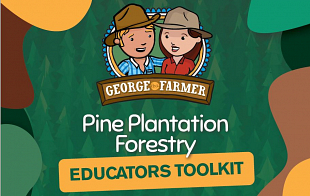George The Farmer – Pine Plantation Forestry
Lesson Overview:
This George the Farmer Educational Resource aims to raise awareness about plantation forests resources, management, the interrelationships within plantation forests, and farming forests.
Resource description
This George the Farmer educational resource is intended as starting points for a cross-curricular approach to learning, based on the George the Farmer YouTube video “George the Farmer Forestry” and its accompanying Virtual Reality (VR) experience ‘George the Farmer Forestry VR’ on YouTube or through the ForestVR app: www.forestlearning.edu.au/forestvr.
Classes are encouraged to look at the video, the VR and read the lyrics to the song included in this resource. Follow up this guide with the Sustainable Forest Plantations educators resource.
The activities seek to complement and extend the enjoyment students will experience from seeing the video and VR, whilst at the same time meeting some of the requirements of curriculum outcomes. The activities in this resource can be printed out for students, or alternatively, display the activity page from the PDF on your electronic white board and have the students use their existing workbooks to complete the task.
The activities in this resource can be printed out for students, or alternatively, display the activity page from the PDF on your interactive white board or import an activity page into your online teaching and learning environment such as Google Slides and have the students use their existing workbooks to complete the task.
MULTIMEDIA LINKS:
GEORGE THE FARMER FORESTRY VIDEO:
GEORGE THE FARMER FORESTRY – VR EXPERIENCE
This resource was produced by George the Farmer Pty Ltd for Primary Producers SA (PPSA). This project is supported by the Department of Agriculture, Water and the Environment, through funding from the Australian Government’s Educating Kids about Agriculture initiative.
Year Level/s:
Key Curriculum Areas / Subject:
National Curriculum Codes:
Strand Content Description:
N/A
General Capabilities:
Cross Curriculum Priorities:
Curriculum Connections:
ScOT Catalogue Terms:
Theme/s:
Resource Type/s:
Primary:
Activity Pack
teacher Resource
George The Farmer - Pine Plantation Forestry
The activities in this resource can be printed out for students, or alternatively, display the activity page from the PDF on your interactive white board or import an activity page into your online teaching and learning environment such as Google Slides and have the students use their existing workbooks to complete the task.
File Size: 5.54 MB
File Type: pdf
Login